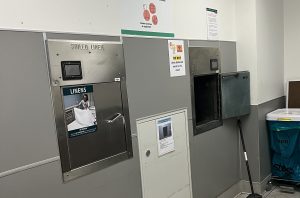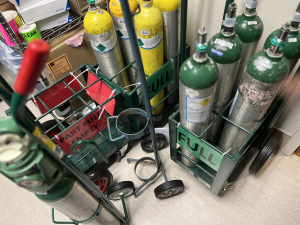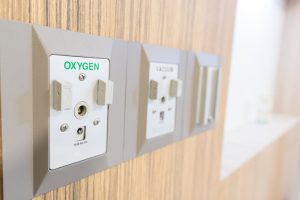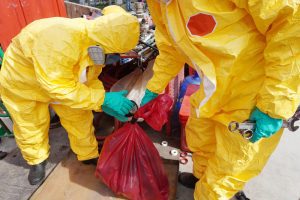April 2025
Inside This Issue
 2024 Sentinel Event Data:
2024 Sentinel Event Data:
The lead article in Perspectives summarizes last year’s sentinel event data. Falls are by far the most frequently reported sentinel event coming in at 49%, followed by delays in treatment, suicide, unintended retention of foreign object and wrong surgery, each with 8% of reported sentinel events. The data indicates that falls actually increased by 15% over 2023, delays in treatment increased 56% and suicide by 72%. The definition of suicide had changed at the beginning of 2024, now extended to 7 days after inpatient discharge, 7 days after an ED visit, and including while receiving treatment in a partial hospitalization program, intensive outpatient program, group home or transitional living, and up to 7 days after discharge from one of those programs. A link was provided for additional details about the 2024 sentinel event report information, but at the time we are writing this, it still contains the 2023 data.
 Opioid Treatment Programs:
Opioid Treatment Programs:
Perspectives also announced a revised OTP chapter, in the Behavioral Health Accreditation Program, that becomes effective July 1, 2025. The chapter is modified based on a new SAMHSA posting in the Federal Register announcing changes in the regulations on Feb 2, 2024. The new OTP chapter is available now on The Joint Commission’s prepublications page of their website. It is nice to see all the OTP requirements in one place and one chapter, rather than being scattered throughout the manual. The prepublication document makes it very clear to see what has been deleted, using strikethrough typeface to identify the deletions. There are many, which should make compliance easier.
New Hospice Standards:
Perspectives also discusses new hospice requirements that have been posted to the prepublication page on TJC’s website. This is a 17-page document, and the new content is underlined in the text. The bad news is that many of the new requirements are simply references to some new requirement in federal code. For example, to do something in accordance with CFRxxxx. The EP text from TJC does not really help to explain each new requirement; you will have to search the federal regulations to understand what really is new or different about each modification. The design of these new elements of performance are somewhat like the life safety code chapter, which has multiple references and details that tie back to an NFPA code book, instead of providing the guidance directly.
 State Licensure Change APR:
State Licensure Change APR:
TJC has posted a modification to APR.01.03.01 for all accreditation programs that takes effect on July 1, 2025. This is the APR that requires an accredited organization to notify TJC of changes in sites and services. Now they are adding a notification requirement for any changes to licensure of the accredited program. You would think that sites and services would already accomplish this, but we assume they got surprised by some licensure change at an organization that changed the nature of the services that had to be evaluated, so they modified the APR. This should not be a challenging modification.
Linen and Waste Chutes:
 This month’s Consistent Interpretation column discusses LS.02.01.50, EP 10, which requires linen and waste chutes to have both self-closing and positive latching devices. This EP was only scored noncompliant in about 4% of surveys last year. The guidance section is, in a word, brief, with only two points of instruction, with one being a restatement of the EP and the second an exception for chute doors that swing open, can be held open with fusible links or an electrical hold open device that will release if heat, smoke or the fire alarm goes off.
This month’s Consistent Interpretation column discusses LS.02.01.50, EP 10, which requires linen and waste chutes to have both self-closing and positive latching devices. This EP was only scored noncompliant in about 4% of surveys last year. The guidance section is, in a word, brief, with only two points of instruction, with one being a restatement of the EP and the second an exception for chute doors that swing open, can be held open with fusible links or an electrical hold open device that will release if heat, smoke or the fire alarm goes off.
 Kitchen Environmental Tour:
Kitchen Environmental Tour:
The lead article in this month’s EC News is a keeper, describing issues a surveyor will evaluate during an environmental tour of the kitchen in your facility. This will be very helpful for your dietary, environment of care, and quality staff to understand the kitchen related issues that can arise from a somewhat generic element of performance.
For example, they point to the most generic standard in the entire manual, EC.02.06.01, EP 1, which requires the environment to meet the needs of the patient population and be safe and suitable. This is the same EP that is sometimes scored for ligatures. In the kitchen, the author points out that they can use this EP to score not having a hand hygiene sink that is separate from kitchen sinks used for washing pots, pans, etc. A second example is EC.02.06.01, EP 20 which states that areas used by patients are clean and free of offensive odors. In the kitchen, they will look for cleanliness behind stoves, on walls, equipment, surfaces and in refrigerators. Additionally, they will look for signs of infestation by vermin and then ask to see work orders or contractor reports to see what you are doing about it.
The article also contains links to some useful FDA guidance on dishwasher temperatures for proper sanitation. The unique fire extinguishers, type K that are required in the kitchen, are also explained in terms of when they should be used, how they work, and what education and signage is required. There is also some very useful guidance on the exhaust hoods above a cooking surface on how to maintain the baffles inside that divert grease into a collection area. Readers will want to share this article with dietary staff, but more importantly use this article to self-evaluate the kitchen area by either your environmental rounds team or quality staff.
Storing Medical Gas Cylinders:
 EC News has a second very useful article on a different but equally problematic issue, storing medical gases. This is an issue that is commonly problematic due to “out of sight storage,” and different delivery vendors bringing full gas cylinders and removing empties from your organization with perhaps minimal supervision. The authors explain that flammable and nonflammable gases must not be stored in the same room or even in an outdoor enclosure.
EC News has a second very useful article on a different but equally problematic issue, storing medical gases. This is an issue that is commonly problematic due to “out of sight storage,” and different delivery vendors bringing full gas cylinders and removing empties from your organization with perhaps minimal supervision. The authors explain that flammable and nonflammable gases must not be stored in the same room or even in an outdoor enclosure.
As you may already be thinking, “which ones are flammable and which ones are not?”, the article restates an existing FAQ that identifies oxygen, carbon dioxide, medical air, nitrogen, nitrous oxide, helium, argon and xenon as nonflammables which may be stored together. They also list the flammables which must be stored separately including acetylene, butane, ammonia, ethane, and propane.
The authors also revisit the decade long problem of storing/separating oxygen cylinders with signage to identify the full vs empty or in use cylinders. TJC still has an FAQ posted on this subject stating that how you store the partials is derived from your policy definitions. For example, your policy may call for cylinders below 500 psi to be defined as empty, and thus they would be stored in the Empty rack, while cylinders above 500 psi could be stored in the Full/Partial rack, or in the Partial rack if you have adopted a 3-rack approach.
Signage as required by EC.02.05.09 EPs 4 and 5, for medical gas storage areas, is always a point of confusion and the authors provide a clear definition of what kind of gas requires which kind of signage. For example:
Oxygen and medical air only- Signage: “Medical gases: NO Smoking or open flame.”
Oxygen + medical air + other nonflammable gases- Signage: “Positive Pressure Gases: No smoking or open flame. Room may have insufficient oxygen. Open door and allow room to ventilate before entering.”
Oxidizing gases such as oxygen and nitrous oxide- Signage: CAUTION: OXIDIZING GAS(ES) STORED WITHIN. NO SMOKING
Lastly, the authors discuss the space requirements for storage of medical gases. A key determinant is the amount of medical gases stored, with different requirements for <300 cubic feet vs between and 300-3000 cubic feet. This looks like the article can be a useful reminder of these requirements and an opportunity to revisit and verify your compliance with these detailed requirements.
Responding to Disasters:
TJC’s newest publication EM Leader continues to have some very useful articles on challenges faced by healthcare organizations in responding to different types of disasters. They provide some very useful issues to consider and highlight some types of disasters that may not have been considered. The focus is not always on standards, but important operational difficulties that can arise during these disasters that may assist others in planning.
 Wildfires:
Wildfires:
This month they discuss two hospitals in the Cedars-Sinai system in California and how they responded to this year’s wildfires. While their hospitals did not have to evacuate, they did face a surge of patients from long term care facilities who did have to evacuate. They repurposed a conference room and drew from some of their Covid experience. They also experienced cell phone outages and power loss in an outpatient cancer center. The center was able to shut down, but they had to figure out how to maintain the integrity of a large volume of refrigerated medications. Staffing also proved difficult with some staff not being able to come to work due to road closures, traffic jams and fires near their own homes forcing evacuation and childcare needs. The hospital quickly contracted with a nearby hotel for staff housing.
Medical Gas Pressure Failure:
 This article highlights a unique type of disaster that occurred in an Ohio hospital where they were servicing two of their four piped medical gas compressors, and the two functioning compressors failed. We don’t think we have ever been to a hospital that conducted a drill for this type of disaster occurrence. When the disaster started, they immediately inventoried their existing oxygen cylinders and determined how many hours they had and began to quickly work on getting more from area partners and vendors. They also immediately began to work on obtaining replacement compressors for those that had failed, and one actually arrived within 12 hours, but the vendor delivered it to the wrong hospital in another state. After the disaster they looked at their HVA and saw that loss of medical oxygen was already there, but not loss of compressors, so that was added. This may be a potential disaster issue readers have never considered for their own disaster preparedness, but this article appears thought provoking.
This article highlights a unique type of disaster that occurred in an Ohio hospital where they were servicing two of their four piped medical gas compressors, and the two functioning compressors failed. We don’t think we have ever been to a hospital that conducted a drill for this type of disaster occurrence. When the disaster started, they immediately inventoried their existing oxygen cylinders and determined how many hours they had and began to quickly work on getting more from area partners and vendors. They also immediately began to work on obtaining replacement compressors for those that had failed, and one actually arrived within 12 hours, but the vendor delivered it to the wrong hospital in another state. After the disaster they looked at their HVA and saw that loss of medical oxygen was already there, but not loss of compressors, so that was added. This may be a potential disaster issue readers have never considered for their own disaster preparedness, but this article appears thought provoking.
Water Disruptions:
 The April issue of EM Leader also has a good review of potential water disruption issues that might occur in a hospital. The authors provide suggestions from an HHS publication entitled “Emergency Water Supply Planning Guide for Hospitals and Healthcare Facilities.” The content was developed by the CDC, EPA, and American Water Works Association.
The April issue of EM Leader also has a good review of potential water disruption issues that might occur in a hospital. The authors provide suggestions from an HHS publication entitled “Emergency Water Supply Planning Guide for Hospitals and Healthcare Facilities.” The content was developed by the CDC, EPA, and American Water Works Association.
The authors of this publication provide 6 suggestions for consideration:
- Develop an emergency water supply plan that is part of your emergency operations plan
- Gather all needed water-related background information and documents (Your TJC BBI is a good start point, then add water supply descriptions and mains, plus facility drawings showing all utilities. Material you have developed for EC.02.05.02, EP 2 should help also.
- Conduct a water use audit as described by CDC in the linked publication
- Identify emergency conservation measures
- Analyze emergency water supply alternatives
- Test your water supply plan in an emergency exercise
 Chemical Decontamination:
Chemical Decontamination:
The last article in EM Leader is about chemical decontamination and it is filled with links to federal resources for first responders and hospitals. TJC has EM.11.01.01, EP 2 that states your HVA must address hazardous materials such as chemical, biological, radiological, and nuclear and the links in this article may prove very helpful to planning and managing such an incident more effectively. JCR has also developed another of their checklist tools for developing decontamination procedures and there is a link to this at the conclusion of the article.
ACHC:
ACHC has two recent blog posts relative to home care and hospice plan of care requirements and they provide suggested guidance for development of both:
- Home Health Plan of Care: A Continuous, Collaborative Approach to Patient-Centered Services
- Excellence in Hospice Care: The Plan of Care
ACHC also has a webinar planned for May 15, Building a Successful Remote Patient Monitoring Program that you can register for. The suggested audience is hospital and health system leaders.
![]()
CIHQ: Upcoming Webinars:
CIHQ has several webinars that may be of interest to readers over the coming weeks. They include managing of CMS complaints, NFPA 72 Fire Alarm Signaling Code, Infection prevention and Control and Laboratory Accreditation. You can read a summary of these webinars and register to attend by visiting the CIHQ Newsroom.
There were no QSO memos posted from CMS this past month. The new CMS administrator was just approved by the Senate, so it may take them some time to start issuing new guidance. Enjoy your spring while you can.
CMS Forecasting:
 There was an article in the Becker’s newsletter, Dr. Oz outlines vision for CMS: 8 notes, that identified several issues Dr. Oz was forecasting as a focus area for CMS including:
There was an article in the Becker’s newsletter, Dr. Oz outlines vision for CMS: 8 notes, that identified several issues Dr. Oz was forecasting as a focus area for CMS including:
- Price transparency enforcement
- Equipping providers with better patient information and less paperwork
- Identifying fraud and abuse
- Focus on prevention, wellness, and chronic disease management
- Artificial intelligence
- Cost savings in Medicaid
While there are not a lot of details on what this vision means, it provides a glimpse at where they might be headed.
CONSULTANT CORNER
Have you heard any industry chatter on an increase of adverse decisions being cited? Unfortunately, we have seen an uptick in requests for response to these unfavorable outcomes. These require an immediate response and has the potential to impact clinical operations and reimbursement or accreditation status.
We are your essential next step – we enable you to deliver a timely and effective response, minimizing disruptions, ensure you retain accreditation status, and recover with resilience.

What We Can Help With…
Preliminary Denial of Accreditation (PDA)
Denial of Accreditation (DA)
Condition Level Deficiency (CLD)
Medicare Deficiency (MedDef)
Medicare Termination
Immediate Jeopardy (IJ)
Immediate Threat to Health and Safety (ITHS)
What We Promise…
1. Immediate Response
- Understanding your adverse decision report and letter
- Assisting in communicating survey outcomes to governing bodies & stakeholders
- Creating a timeline of deadlines and anticipated events
- Advising critical documents including clarifications, evidence of standards compliance, plans of corrections, appeal letters, and hearing materials
2. Achieving Compliance
- Implementing ESC and POC and validate your compliance pre-resurvey
- Staff education/competency
- Validating compliance with a mock survey
- Organizing evidence of compliance
- Drafting policies, procedures, processes, documents, and other materials to support compliance
3. Sustaining Compliance
- Monitoring compliance and report results
- Recurring mock surveys and focus visits to validate ongoing compliance
- Support for continuous performance improvement
- Continuous Accreditation Support (CAS) Program: Onsite and Offsite Support; Portal Access to Tools, Checklists, Guides, Resources, and more!
Thank You!
Jennifer Cowel, RN MHSA
JenCowel@PattonHC.com
Kurt Patton, MS RPh
Kurt@PattonHC.com
Julia Finken, RN, BSN, MBA, CPHQ
julia.finken@hbsinc.com
John Rosing, MHA
JohnRosing@PattonHC.com
